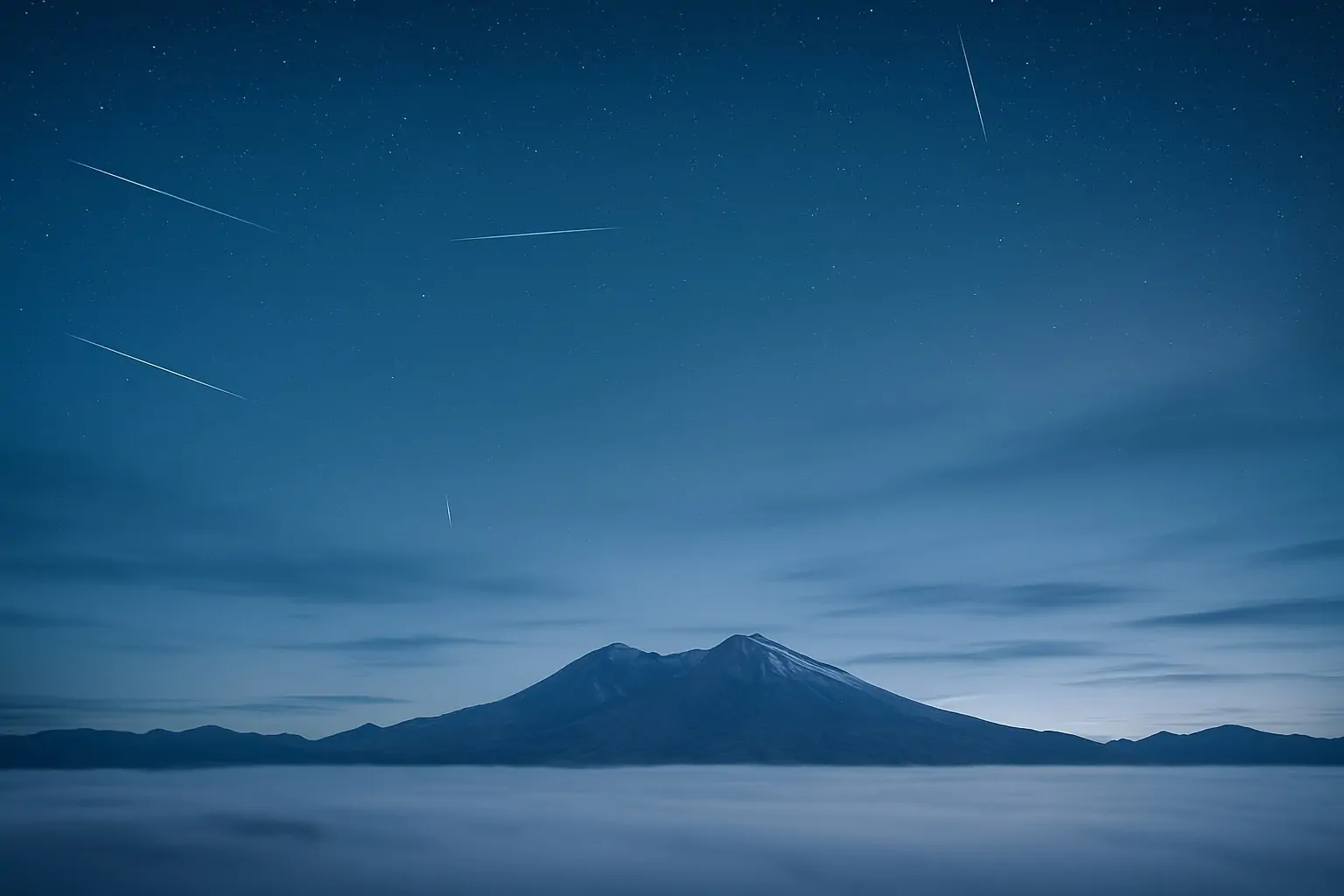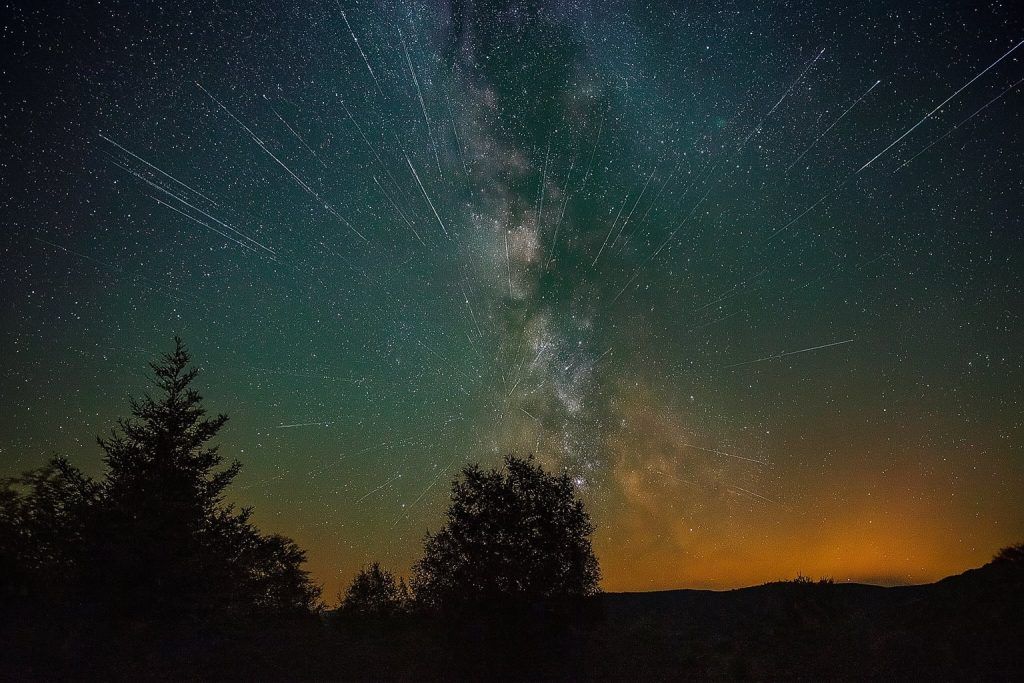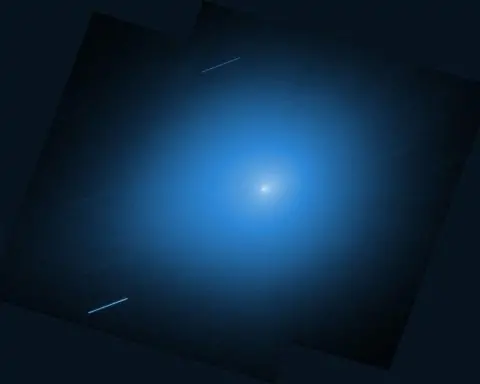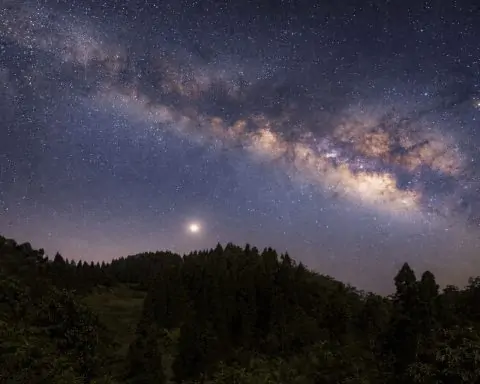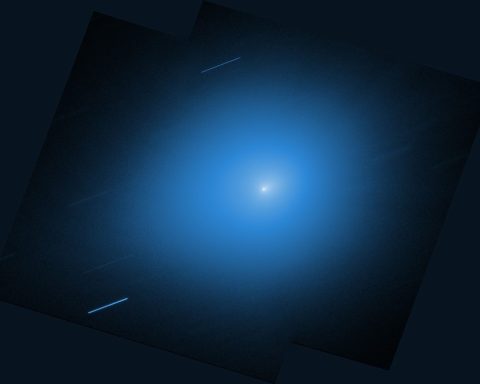- Two meteor showers—Southern Delta Aquariids and Alpha Capricornids—are near peak around July 30, 2025, with the best viewing on the nights of July 29–31 under dark skies.
- Southern Delta Aquariids originate from debris of comet 96P/Machholz and run roughly July 18–August 12, with ideal conditions producing about 15–20 meteors per hour.
- Alpha Capricornids peak around July 30 and are known for slow, bright fireballs with long-lasting trails, linked to the parent body 169P/NEAT.
- The Moon will be about 27% illuminated at the peak, reducing moonlight interference with meteor visibility.
- Venus (magnitude −4.1) and Jupiter (magnitude −1.9) are visible in the pre‑dawn sky and will approach a close conjunction in mid‑August, less than 1 degree apart on August 12.
- Saturn (magnitude +0.9) rises around midnight and shines in the predawn sky, with Neptune (magnitude about 7.7) lying very close nearby at roughly 1 degree separation.
- Mars (magnitude +1.4) remains a modest evening object in the western sky, and a crescent Moon passed very close to Mars on July 28.
- Mercury is at inferior conjunction around July 30 and is not visible during this period, with a return to the morning sky in August.
- Moon–Spica conjunction occurs on July 30, with the Moon near Spica in Virgo and separated by about 3–4 degrees, both setting about 2 hours after sunset.
- The International Space Station (ISS) offers multiple evening passes around July 27–31 for mid‑latitude observers, with Los Angeles seeing two passes on July 28 at 8:43 PM and 10:17 PM PT.
Twin Meteor Showers Illuminate Late July Nights
As July 2025 comes to a close, skywatchers are in for a double treat: two meteor showers peaking at the same time. From the late hours of July 29 into the pre-dawn of July 30, the Southern Delta Aquariids and the Alpha Capricornids will both be near peak activity, potentially yielding dozens of meteors per hour under dark skies [1]. These twin showers remain active through mid-August [2], but the best viewing is around July 30 when they overlap. Crucially, the moon will be only about 27% illuminated during the peak night, so moonlight won’t interfere much with meteor visibility [3].
- Southern Delta Aquariids: This annual shower originates from debris of comet 96P/Machholz. It’s active from roughly July 18 to August 12 [4] [5]. The meteors are generally faint and lack bright tails, and the shower doesn’t have a sharp peak (it “rambles along steadily” in late July) [6]. Under ideal dark-sky conditions with the radiant high, the Delta Aquariids can produce around 15–20 meteors per hour at maximum [7]. However, observers at northern latitudes see lower rates (the radiant in Aquarius stays low in the south) [8]. The best views are in the Southern Hemisphere or southern U.S. – where Aquarius climbs higher – especially after midnight until dawn. About 5–10% of Delta Aquariid meteors leave persistent trains of ionized gas that linger for a second or two [9], but fireballs are uncommon (these meteors tend to be on the dim side).
- Alpha Capricornids: Running in parallel with the Aquariids, the Alpha Capricornid shower is weaker in terms of count, peaking around July 30 as well. It may only produce a few meteors per hour, but it makes up for quantity with quality. This shower is known for slow, bright fireballs – exceptionally bright meteors with long-lasting trails [10]. Those “extra bright meteors” are truly eye-catching [11]. The Alpha Capricornids’ parent body is thought to be comet 169P/NEAT [12]. Like the Aquariids, it’s best viewed from the Southern Hemisphere or lower latitudes of the Northern Hemisphere [13]. Even a few fireballs can make it worthwhile to watch, as they can rival Venus in brilliance.
Viewing Tips: To enjoy the meteor double-feature, find a dark viewing spot away from city lights on the night of July 29–30 (and also July 30–31, as activity remains good for a few days). After midnight, lie back and let your eyes adapt (about 20–30 minutes). No telescopes or binoculars are needed – use your naked eyes to scan as much sky as possible. The Delta Aquariid meteors will appear to radiate from the south (near the Aquarius constellation), while any early Perseid meteors (just beginning to trickle in by late July) will flash from the northeast (Perseus) – and Alpha Capricornids from the Capricornus area. In fact, by the end of July the Perseid meteor shower is ramping up too (it peaks in August), so you may catch a few Perseid fireballs in addition to the Aquariids [14]. Seasoned observers say it’s fun to try identifying which shower a meteor belongs to, based on its speed and direction [15]. Overall, expect a mixed flurry of shooting stars crisscrossing the sky on these moonless late July nights.
“Near the peak on July 31, if the radiant were overhead it would produce about 25 meteors per hour… Watch for maybe a dozen meteors per hour.” — Astronomy Magazine, on the Southern Delta Aquariid rates in 2025 [16]. In practice, combined with a few Alpha Capricornids and early Perseids, meteor watchers could indeed see several dozen meteors over the course of each dark hour [17]. Remember that meteor counts can be hit-or-miss – patience is key. Get comfortable (bring a lounge chair or blanket and perhaps a hot drink) and enjoy the balmy summer night show.
Aurora Watch: High-Latitude Sky Glow Possible
While the northern lights are not guaranteed this week, there is a chance that observers in far-northern regions could spot a gentle auroral display. In late July 2025 the sun has been active, with a high number of minor solar flares and some coronal holes on the Sun’s surface [18] [19]. According to space weather forecasts, a high-speed solar wind stream from a coronal hole was expected to reach Earth around July 30–31 [20]. NOAA and spaceweather experts noted this could lead to unsettled geomagnetic conditions and even a brief G1-class (Minor) geomagnetic storm at high latitudes [21].
- What this means: If the solar wind stream arrives as anticipated, the Earth’s magnetic field might energize for a period, possibly sparking auroras at high latitudes. A G1 geomagnetic storm is relatively mild, but it can produce auroral glows visible in places like Canada, Alaska, Northern Europe, and the northern-tier U.S. states (especially along the horizon) [22]. The peak opportunity would be late on July 30 through July 31’s early hours.
- Current conditions: As of July 30, Earth’s geomagnetic field has been mostly quiet to unsettled (Kp index in the 1–3 range) [23]. No major Earth-directed solar eruptions (CMEs) have occurred in recent days [24], so no big geomagnetic storm is ongoing. The slight aurora potential comes mainly from the coronal hole’s high-speed wind. Spaceweather forecasters gave roughly a 15–25% chance of active aurora conditions on July 30–31 at mid-to-high latitudes [25]. In practical terms, that means auroras are far from guaranteed, but it’s worth keeping an eye on real-time aurora dashboards if you live in a high-latitude area. Any auroras that do occur will likely be relatively faint greenish glows or modest curtains low on the horizon, rather than dramatic overhead displays.
Bottom line: Don’t expect a major aurora storm, but aurora aficionados should stay alert. If you’re in northern locales, check the aurora oval forecast on the night of July 30/31. Clear, dark skies free of light pollution will improve your chances of detecting any subtle auroral glow. Even a minor geomagnetic uptick could “light up the night sky” with a tint of green or red at the horizon [26]. For most skywatchers, the meteor showers will be the more noticeable spectacle – but a lucky few far north might get a bonus aurora in the mix.
Planets on Parade at Dusk and Dawn
Late July 2025 offers plenty of planetary eye-candy, especially in the early morning hours. Several bright planets are positioned for viewing, and a beautiful Moon+star conjunction graces the evening of July 30:
- Venus and Jupiter (Morning Sky): The two brightest planets in Earth’s sky are finally sharing the stage again. Venus has been blazing in the east before sunrise all month, and by the end of July Jupiter has rejoined it in the pre-dawn sky [27]. Early risers will see brilliant white Venus (magnitude –4.1) high in the east in the hour or two before sunrise. Jupiter, though dimmer (around mag –1.9), is now climbing out of the glare of dawn – by July 30 it appears low on the eastern horizon about an hour before sunrise, just below Venus’ position [28]. Each morning Jupiter will rise a bit higher and draw nearer to Venus [29] [30]. Together, they make a striking pair: Venus is higher and vastly brighter; Jupiter is lower but still conspicuous in the twilight. This is the beginning of an extended rendezvous – the two planets are headed for an exceptionally close conjunction in mid-August (on August 12 they’ll appear less than a degree apart) [31]. For now, throughout July 30–31 and into early August, look east before dawn to catch Venus “chasing” Jupiter. (They are in the constellations Taurus/Gemini area – Venus currently in northwestern Orion moving into Gemini, and Jupiter in western Gemini [32] [33].) On July 21–22, observers were already treated to a spectacular scene with the crescent Moon, Venus, and Jupiter forming a lineup in the morning sky [34]. Though the Moon has since moved on, Venus and Jupiter alone are a gorgeous sight. Tip: As dawn brightens, Venus is visible even in daylight if you know where to look – but use binoculars only before sunrise, never after the Sun is up, to avoid eye injury.
- Saturn (Late Night):Saturn is rising earlier each week as it approaches its August opposition. By July 30, Saturn rises around midnight local time and soars highest in the south by the predawn hours [35]. It shines at about magnitude +0.9 in the constellation Pisces, easy to spot as a yellowish “star” in late-night skies. If you’re up watching meteors or Venus/Jupiter, turn south and you’ll find Saturn high in the sky before dawn. This is a great time to observe Saturn with a telescope – its rings are tilted toward us and still very impressive. In fact, telescope users take note: Neptune (magnitude ~7.7, not visible to the naked eye) is positioned extremely close to Saturn on the sky this month, only about 1 degree apart (that’s two Moon-widths) [36]. They rise together and can potentially be viewed in the same low-power telescope field – a rare configuration to see two planets nearly side by side. (Neptune lies just a degree north of Saturn in Pisces [37].) Seeing the distant ice-blue disk of Neptune so near Saturn and its rings is a unique treat for experienced observers. Saturn will reach opposition (its brightest, closest point of the year) in late August 2025, but already it’s gaining prominence each night.
- Mars and Mercury (Evening): Over in the evening twilight, Mars is still hanging on, though it’s now a modest, fading dot. The Red Planet resides low in the west after sunset, amid the stars of Leo/Virgo. At magnitude +1.4 and getting dimmer, Mars can be challenging to spot in the twilight glow [38]. It sets only an hour or two after the Sun by end of July [39]. Notably, on July 28 the slender crescent Moon passed extremely close to Mars in the dusk sky [40] – a pretty pairing that some observers caught as a tiny crescent next to a ruddy “star”. That marked one of Mars’ last noteworthy appearances for a while. Each night Mars will be a bit lower; by late August it will disappear behind the Sun. Mercury, for its part, had a brief showing in early July (reaching a good evening elongation in the first week [41]), but by now Mercury has vanished into the Sun’s glare. In fact, Mercury is at inferior conjunction (passing between Earth and Sun) around July 30, so it’s not visible during this Skywatch period [42]. It will reappear in the morning sky later in August.
Moon Meets Spica – July 30: On the exact evening of July 30, be sure to check out the Moon’s lovely encounter with Spica. Spica is the brightest star in the constellation Virgo and shines with a bluish tint. Shortly after sunset on Wed. July 30, you’ll see the waxing crescent Moon (about one-third illuminated) hanging low in the southwestern sky. Look about 20° above the horizon (roughly two fist-widths at arm’s length) in the hour after sunset, and you’ll spot the Moon with Spica glimmering just a few degrees to its upper left [43]. They’ll be quite close: around 3°–4° apart (the Moon will not occult Spica for most of the world, though an actual occultation of Spica by the Moon is happening for parts of Antarctica) [44] [45]. This Moon–Spica conjunction will be easily visible to the naked eye and makes a great photo opportunity. The contrast of the Moon’s golden crescent against Spica’s icy-blue light should be striking. Both objects set roughly 2 hours after the Sun on July 30, so there’s a limited window to observe this pairing [46]. As twilight fades, more of Virgo’s fainter stars will come into view around the Moon. (Fun fact: Spica isn’t a single star at all, but a binary star system whose two massive components orbit each other closely, their combined light appearing as one bluish star to us [47].) If you have binoculars or a small telescope, also take a look at the Moon itself – features like Mare Crisium and the “Seas” of Serenity and Tranquility will be visible as dark patches on the lunar surface near the terminator (the day-night line) [48].
In addition, the summer constellations are in full glory. Aquila, the Eagle (with bright star Altair) is rising in the east after dusk [49], joining bright Vega and Deneb to complete the Summer Triangle overhead. The Milky Way’s dense star clouds run through Cygnus, Aquila, and down to Sagittarius in the south – July evenings are perfect for Milky Way gazing if you can get to a dark site. Overall, between the bright planets at dawn, the pretty Moon-and-star tableaux at dusk, and the starry summer skies, there’s no shortage of things to see even when meteors or auroras aren’t flashing.
Bonus: ISS Flyovers and Satellite Spotting
Rounding out the skywatching alert, human-made “stars” are also gracing the heavens. The International Space Station (ISS) – the largest satellite of Earth – is making a series of bright evening passes over many populated areas in late July. In fact, around July 27–31 the ISS’s orbit geometry is such that it’s visible multiple times per night from mid-northern latitudes. Skywatchers across the United States (and similarly latitudes in Europe and Asia) have prime opportunities to see the ISS glide overhead [50].
For example, observers in Los Angeles saw the ISS twice on July 28 (at 8:43 PM and 10:17 PM PT), with more passes on subsequent nights; New Yorkers caught it around 10:11 PM on July 27 and again at 9:22 PM on July 28, with additional flyovers expected on July 30 as well [51]. Most ISS appearances occur within a couple hours after sunset or before sunrise – that’s when the station’s reflective panels catch the Sun’s rays against the night sky. The ISS appears as a bright, steady moving point of light, usually rivaling Venus in brightness, trekking across the stars in a matter of a few minutes [52]. Unlike airplanes, it does not blink or have colored lights – it shines with a constant white glow as it moves at 28,000 km/h (17,500 mph) 400 km above Earth [53] [54].
How to spot it: When a pass is due, simply go outside at the given time and look in the specified direction (NASA’s Spot the Station website provides precise local sky directions and elevations). If you’re in the right place at the right time, you’ll suddenly notice what looks like an unusually bright star slowly creeping across the sky. The ISS typically takes about 4–6 minutes to cross from one horizon to the other. It can appear in the west and disappear in the east (or vice versa), often fading out as it enters Earth’s shadow. No telescope needed! In fact, the station is best seen with the unaided eye or binoculars – in a telescope it will zip through the view too fast. To find out when it will fly over your area, use NASA’s Spot the Station tracker (a web tool and app) which will list upcoming sighting times for your city [55]. Many skywatchers set alerts for these passes, as it’s always a thrill to see the ISS – essentially a flying city – soar silently overhead. And remember, the astronauts on board experience a “sunset” every 45 minutes; when you watch the ISS pass at night, you’re seeing sunlight reflecting off its solar panels while you stand in Earth’s shadow – a neat reminder of orbital mechanics!
Other satellites can also be seen if you’re patient. In dark skies, you might catch faint satellites moving among the stars every so often. Notably, Starlink satellite “trains” (strings of newly launched satellites) occasionally create a buzz when visible, though none are specifically timed for July 30–31 in particular. If you do spot a line of dots moving in formation, you’ve likely caught a Starlink deployment. Otherwise, single satellites like China’s Tiangong space station (much fainter than ISS) or various rocket bodies can sometimes flare into view. These are a bonus for the vigilant observer. The key takeaway: keep watching the skies, and you never know what might drift by.
Sources: This report is based on the latest guidance and expert commentary from NASA and astronomy outlets. NASA’s Skywatching team highlights the planetary line-up and Moon events [56] [57], while Discover Magazine and EarthSky provide details on the meteor showers and viewing tips [58] [59]. Space weather experts at EarthSky summarize the aurora outlook amid recent solar activity [60]. City-specific ISS viewing times were reported via NASA and news sources [61]. For further details and daily updates, check resources like NASA’s What’s Up newsletter and Spaceweather.com, or your local planetarium’s sky bulletin. Happy skywatching, and clear skies!
References
1. www.discovermagazine.com, 2. www.discovermagazine.com, 3. www.discovermagazine.com, 4. science.nasa.gov, 5. science.nasa.gov, 6. earthsky.org, 7. earthsky.org, 8. earthsky.org, 9. earthsky.org, 10. www.discovermagazine.com, 11. www.discovermagazine.com, 12. www.discovermagazine.com, 13. www.discovermagazine.com, 14. www.astronomy.com, 15. www.astronomy.com, 16. www.astronomy.com, 17. www.discovermagazine.com, 18. earthsky.org, 19. earthsky.org, 20. earthsky.org, 21. earthsky.org, 22. earthsky.org, 23. earthsky.org, 24. earthsky.org, 25. earthsky.org, 26. earthsky.org, 27. www.astronomy.com, 28. www.astronomy.com, 29. science.nasa.gov, 30. science.nasa.gov, 31. earthsky.org, 32. whenthecurveslineup.com, 33. www.astronomy.com, 34. science.nasa.gov, 35. science.nasa.gov, 36. www.astronomy.com, 37. www.astronomy.com, 38. www.astronomy.com, 39. www.astronomy.com, 40. science.nasa.gov, 41. science.nasa.gov, 42. www.astronomy.com, 43. www.space.com, 44. in-the-sky.org, 45. www.space.com, 46. www.space.com, 47. www.space.com, 48. www.space.com, 49. science.nasa.gov, 50. economictimes.indiatimes.com, 51. economictimes.indiatimes.com, 52. economictimes.indiatimes.com, 53. economictimes.indiatimes.com, 54. economictimes.indiatimes.com, 55. economictimes.indiatimes.com, 56. science.nasa.gov, 57. science.nasa.gov, 58. www.discovermagazine.com, 59. earthsky.org, 60. earthsky.org, 61. economictimes.indiatimes.com
